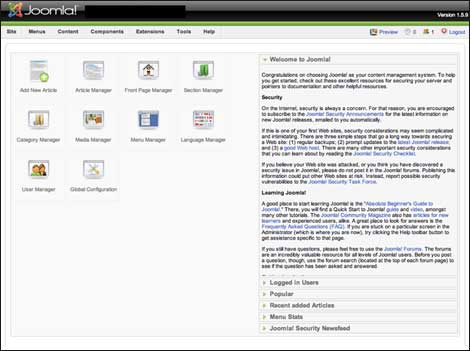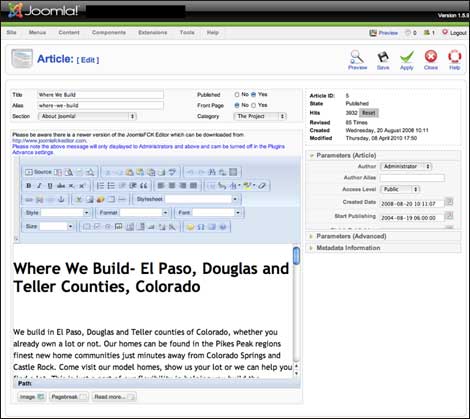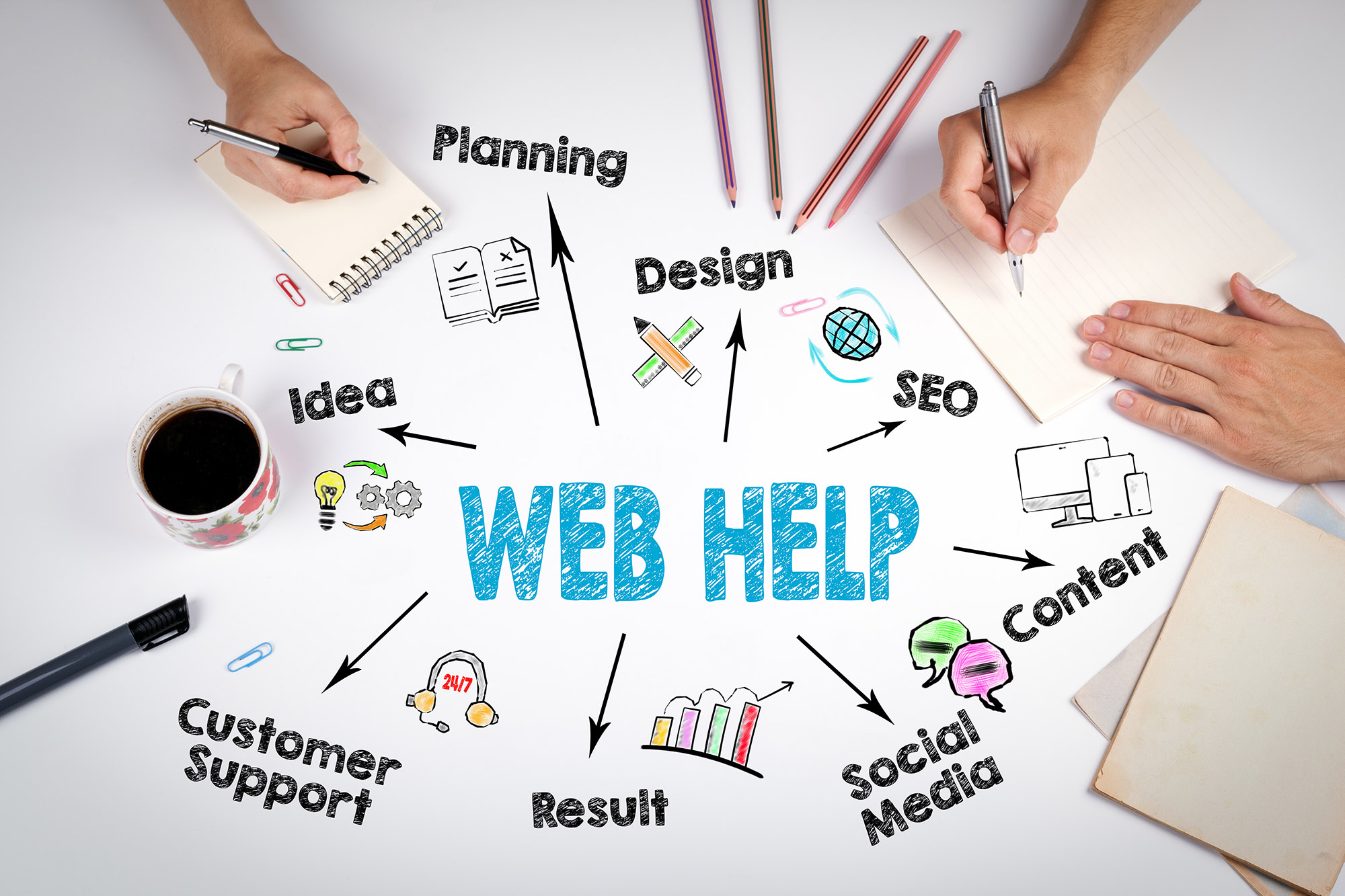Objective
This is a brief review of the Joomla CMS (Content Management System). The article will discuss the key issues and benefits of using the Joomla open source CMS system to build Websites. This is also a discussion of the pros and cons of Joomla CMS versus static HTML Websites.
Joomla was selected as the technology of choice by Intuitive Websites for non-eCommerce Websites after much experience with a variety of software and development platforms including .NET, Flash, Cold Fusion, Front Page and DreamWeaver to name a few. Joomla outperforms these software options in several areas described in this document.
What is Joomla?
Joomla is a Website development platform that pulls content from a database and displays it on template based pages on the Web. The database separates the Website’s content (text, photos and media) from its structure (design, functionality and code). This separation allows two things to happen:
- Users can edit page content via a Web browser while Web developers can simultaneously but separately edit the site’s structure.
- Developers can make site wide changes by editing the template one time instead of making redundant edits to every page on the site.
Joomla CMS Strategy Summary
Joomla works best with Websites that depend on content based strategies to drive results. These are usually sites whose purpose is lead generation or branding. Because content drives results, it is important to have the flexibility to add new content and edit existing content from a Web browser as needed. Content management is the major strength of Joomla. If the Website needs content to drive results, then Joomla is the best solution.
Why Build a Joomla CMS Website?
The three key objectives behind a Joomla Website include the following:
- Joomla allows users to edit the site from any browser.
- Joomla templates improve design with CMS templates that are flexible, easy to modify and easily integrate with current content, photos, logos and graphics.
- Flexibility in the design, content and Web modules allow for a more dynamic Website that will peak user interest, driving inquiries to the sales team and online sales.
In order to allow for more flexible site updates and content modifications, a Joomla CMS Website is recommended. It is very common for Google to index hundreds of Website pages and using DreamWeaver or static HTML to edit a large Website is like having multiple users editing a large word processing document and saving it every time they complete their edits. This will result in limited access to the Website and lost work as users save over each other’s work.
Project management and site accessibility is very limited when working on large HTML Websites. Websites need to be dynamic and allow multiple users to edit the site as needed. The site should also have a professional and modern looking design that is flexible and can be easily modified from a template, which saves development and coding costs. Joomla CMS allows for this and much more.
Why Use Open Source CMS?
Open source software, like Joomla, has been around since the early days of the World Wide Web in the 1990s. It has grown increasingly in popularity and is now a mainstream in Website development. Developers from around the world prepare the code for the CMS software and it is downloaded for free by Website developers and designers. An organization is formed to monitor and set standards for the CMS software and the release of new versions.
Open source applications have exploded as technology consumers move away from the concept of licensing fee based software to readily available code that can be used for free. Not only is the code free, but it is also updated and improved by the huge team of developers that also create plugins and other modules that enhance the functionality. This is the future of major software applications for both online and offline applications. The days of a developer writing code and then licensing that code will soon be gone to the great benefit of Website owners that will now have access to the site’s source code. This puts the value emphasis on the developer and not the code.
This concept has also taken hold among small businesses who want to customize Web applications to meet their needs, rather than rely on licensed software products that come with limitations, restrictions and additional costs. Costs are less with open source because you pay for installation and set-up of the application, rather than the fees to buy the software. Best of all, the code can be edited at any time to improve site functionality.
Joomla is the most popular of the open source CMS programs in PHP programming language and was selected by Intuitive Websites following much research and work with other HTML tools and .NET applications.
The Joomla Interface
The CMS interface in Joomla is easy to use, so non-programmers can perform tasks that were difficult in HTML and on static page Websites. The interface is clean and allows for multiple staff members to make site updates without the risk of over-writing each other’s work. The CMS manages the database of content and placement on the page so programming is not required. This also saves money.
Here is a screen shot of the Joomla user interface screen:

Here is an example of the Joomla editor:

Here are just a few examples of Websites that use Joomla:
- MTV Networks Quizilla (Social networking)
- IHOP (Restaurant chain)
- Harvard University (Educational)
- Outdoor Photographer
- PlayShakespeare.com (Cultural)
- Senso Interiors (Furniture design)
More examples of companies using Joomla can be found in the Joomla Community Site Showcase.
Here are a few examples of Websites built by Intuitive Websites in Joomla:
- www.Xtivia.com
- www.Virtual-DBA.com
- www.DoyleResearch.com
- www.RGiInsurance.com
- www.CopperleafHomes.com
- www.SalesEffectiveness.com
- www.WebbFoodServiceDesign.com
Because it is open source and has a large community of programmers, Joomla has thousands of extensions and plugins to modify and improve the site as needed. These include modules for eCommerce, calculators, registrations, calendars, galleries, document services, social networking, blogs and much more. More information on these extensions and software plugins can be found at the following link:
Joomla templates are also cross-browser tested for Mac and PC and look good on all browsers, requiring less programming and testing. Also, Joomla notifies the developer when updates are available and they can be downloaded for free.
Content can be set to publish immediately or on a given date so the site can always be fresh and multiple pages can be written at one time and then show up on the Website when needed. This is an especially important function for content rich Websites. It is also important for content that is driven by dates, like seminars and workshops or email newsletters. Content can be automatically posted on the Website by publish date and also removed as needed.
A demo of the Joomla back-end can be performed at any time by an Intuitive Websites team member. Learn more about Joomla at www.Joomla.org. Learn more about open source initiatives at www.OpenSource.org.
Static HTML vs. Joomla CMS
Static HTML Websites work best for small brochure type sites that have few updates and pages. They are most often created in software programs such as DreamWeaver or by programmers writing HTML code. Static page Websites are generally cheaper at the start of the process, but the up-keep and maintenance of large Websites will make it more expensive to edit and update in HTML over time. Joomla CMS is faster and easier to edit and can cut Web staff time considerably.
CMS Websites handle the code in a much more robust and flexible manner than an HTML editor. This saves time and money as internal staff can be responsible for Website edits and modifications. This leads to less time spent with a Web language programmer (PHP or ASP), DreamWeaver or HTML programmer. There is no need to re-write pages that are over-written during the editing process in HTML.
The bottom line is that both static HTML pages and CMS pages can work. But because of the size of many content rich Websites and their need for a variety of modules, content published by dates and the large amount of content pages, Joomla CMS is recommended.
CMS Security
There can be security issues with all servers and Websites. There is not a greater security risk with Joomla because it is open source or a CMS system. The best way to keep any site secure is to first select a solid and dependable hosting company with regular back-ups and a solid history of secure Website hosting. Intuitive Websites will handle this for our clients. Websites should also be backed-up weekly so if attacked a fresh back-up is ready to be installed. Second, make sure the user name and password for the site are in safe hands at all times and changed on a regular basis. The biggest issue around site security is the login information getting into the wrong hands.
Various levels of access can also be granted via the Joomla CMS login so users can be set-up to have full access as administrators or more basic levels of access as basic content editors. Joomla also allows for page restrictions based on the user’s access level to edit the site.
SEO (Search Engine Optimization) and Joomla Improvements
Several years ago the major search engines struggled with dynamic pages and how to index them for search results. This happened for a variety of reasons, but primarily because most sites in the early days of the Web were static HTML sites and the search engines were programmed to find HTML pages and index the related pages. This changed about four or five years ago as Google noticed the explosion of dynamic Websites and began changing their technology to make sure these sites were listed in search reports. Currently, there is no longer any relevance to this issue as Joomla and other CMS Websites dominate the Intranet and Google indexes these sites so they show in the search results. Other search engines followed Google.
Intuitive Websites has been working with Joomla for over four years and have seen significant improvements in our clients’ search results using the same fundamental SEO principles, but implemented on Joomla Websites. Joomla uses search engine friendly URLs and the code of each Joomla page is indexed by Google. Also, Google will see this site as new content and pages because it is a new Website and this may cause rankings to improve as Google indexes the new content.
The growth in Joomla as a Web development platform and the attention it has received from Google are two key indicators that it is an effective and successful development platform.
Joomla CMS Software Updates
Joomla software updates and improvements become available on a regular basis. Intuitive Websites tracks these updates and will recommend to our clients when an upgrade is needed to improve functionality or the back-end editor. Most new Websites do not need any upgrades for one to two years minimum following the development and launch of the new Joomla Website.
Intuitive Websites will upgrade our clients’ Websites to new versions of Joomla when needed to meet their strategic Web marketing needs. Joomla upgrades are seamless and use as a patch upgrade, which require very little work, no downtime for the site and virtually no cost. All Websites should be backed-up before any upgrades are performed for extra security.
Conversion to Joomla from HTML
Content is the most important consideration when converting a Website to Joomla from static HTML or other development platforms. This process works best when there is a well-defined process for the transition. Content includes written content, photos, images, graphics, videos and other data.
The first step is to outline a detailed site map and assign content to each page of the site map. This is followed by template and graphic design selections. Together these two steps are used to develop the structure for the new Joomla Website. Content is then cut and pasted into each page and formatted via the established design guidelines for each page.
Current links can be cut and pasted into the content. The page URL addresses can be changed or kept the same if needed, but many links will need to be added manually, which is very easy to do in the Joomla editor. The Website development staff should be trained on all aspects of this data and content conversion process. All search engine optimized code from the HTML site should be copied over to the new pages.
It does take work to make this conversion happen, but things go much easier if they are planned in advance, including interior page design guidelines and formats for content. The payoff comes in the use of the new site and the design flexibility for future modifications that come with Joomla.
Cost/Benefit Analysis
The cost/benefit analysis for the Joomla Website is very promising. It is comprised of time and money savings, along with better Website performance.
Time and Money Savings
- It will take less time to edit the Website.
- More staff and team members can add content simultaneously saving project management costs and speeding up development time.
- Work on the site will not be overwritten, resulting in having to re-create pages and redundant work.
- Templates can be changed and modified in the CMS program, which greatly reduce design and development costs.
- Joomla modules require minimum program and most are free to install.
- A minimum amount of technical support will be needed to maintain the site.
Improved Website Performance
- A professional Joomla template will give the site more credibility and a more modern look, which builds trust and leads to a higher conversion rate.
- It will be easier to create and edit new Web pages.
- Continued SEO of all new pages will drive search results.
- Improved functionality and an easier to use Website interface will drive conversions.
All of these costs and benefits can be tracked in the Intuitive Websites Monthly Website Performance program. The Intuitive Websites team has the capabilities to develop static HTML pages for any Website, but we can’t recommend this as the best option for a successful Web marketing strategy. Intuitive Websites considers it our obligation to track Web successes that drive ROI from both our development and marketing efforts. This is why we have chosen Joomla as our development platform of choice for content based Websites.


